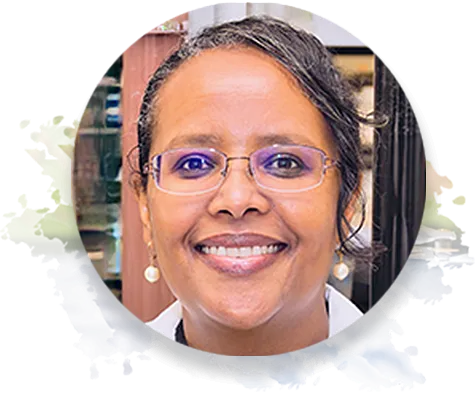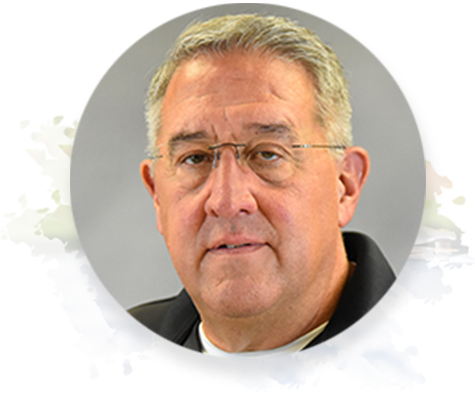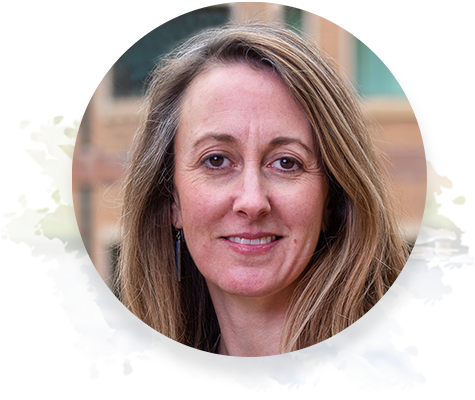
Keynotes & lectureship speakers
Opening keynote panel
"40 Years into the Future"

Asmeret Asefaw Berhe
Keynote Panel Moderator
Asmeret Asefaw Berhe is a Professor of Soil Biogeochemistry and Falasco Chair in Earth Sciences and Geology at the University of California, Merced. She previously served as the Director of the US Department of Energy’s Office of Science (Senate confirmed, Presidential Nomination). Her research interest lies at the intersection of soil science, geochemistry, global change science, and political ecology. Professor Berhe’s work seeks to improve our understanding of how the soil system regulates the earth’s climate and the dynamic two-way relationship between soil and human communities. Numerous awards and honors have recognized her scholarly contributions and efforts to improve equity and inclusion in STEM. She is an Elected member of the US National Academy of Engineering, a Fellow of the American Geophysical Union and the Geological Society of America, and a member of the inaugural class of the US National Academies of Science, Engineering, and Medicine's New Voices in Science, Engineering, and Medicine.

Jayson Lusk
Agricultural Economist/Climate Futurist
Jayson Lusk currently serves as Vice President and Dean of the Division of Agricultural Sciences and Natural Resources (OSU Agriculture) and Regents Professor at Oklahoma State University. He has served on the editorial councils of eight academic journals including the American Journal of Agricultural Economics, Journal of Environmental Economics and Management, and Food Policy and consulted for various nonprofits, government agencies, and agribusinesses. Jayson has further been honored by being elected to and serving on the executive committees of the three largest U.S. agricultural economics associations, including most recently the Agricultural and Applied Economics Association, of which he is a past-president and fellow. In the wake of COVID-19, he has been interviewed by dozens of television, radio, and print journalist seeking information about food system impacts, including mentions in the New York Times, Washington Post, CNN.com, FoxNews.com, Financial Times, LA Times, Reuters, Bloomberg, NPR, Freakonomics and more.

Stella Salvo
Philanthropist/Humanitarian
Stella Salvo is Head of Breeding Partnerships for Smallholder Farming at Bayer Crop Science, part of the Global Breeding organization in Research & Development. Based in St. Louis, Missouri, Stella is responsible for driving public-private partnerships seeking to make positive impacts for the livelihoods of smallholder farmers. Stella holds a PhD and Master of Science in Plant Breeding and Genetics from the University of Wisconsin and Colorado State University, respectively, along with a Bachelor of Science in International Agronomy with a minor in International Studies in Agriculture from Purdue University. In addition to serving the tri-societies as Chair of the Agronomic Science Foundation, Stella also serves on the Advisory Board to the International Rescue Committee Airbel Impact Lab on Seed Security and the Feed the Future Innovation Lab for Soybean Value Chain Research.

Scott Shearer
Agricultural Technology Futurist
Scott Shearer received his Ph.D. in agricultural engineering from The Ohio State University (OSU) in 1986. Currently, he serves as Professor and Chair of Food, Agricultural and Biological Engineering at OSU. Highlights of his research career include development of methodologies and controls for metering and spatial applying crop production inputs, modeling of agricultural field machinery systems, autonomous multi-vehicle field production systems and strategies for deployment of UAVs in agriculture. He has lead research supported by over $15M in grants, authored more than 200 technical publications, and has made numerous invited presentations at international conferences, professional meetings and farmer forums. Dr. Shearer is a Fellow of the American Society of Agricultural and Biological Engineers.
ASF morning plenaries
New in 2025: CANVAS plenaries open to all
Tickets are no longer required, and complimentary coffee will be available in the plenary room
Mon–Wed from 6:45 to 9:00 AM.
Breakfast items, including hot options, will be available for purchase at nearby credit card-only kiosks.
Nyle C. Brady Frontiers of Soil Science Lectureship
"Soil Physics through Time: Evolution, Innovation, and the Road Ahead"
The soil physics community has come a long way by undergoing remarkable transformations in the past and evolving from experimental approaches rooted in agricultural needs to a highly interdisciplinary field intersecting with hydrology, physics, chemistry, biology and climate science. In this talk, the historical evolution of soil physics from fundamental work to the integration of theoretical, computational, and experimental advances will be introduced. Furthermore, key innovations that have greatly reshaped our understanding of various phenomena in soil physics will be highlighted. Finally, emerging challenges and opportunities in climate-driven extremes, improving predictions at larger scales, and bridging the gap between mechanistic models and data-rich observations will be addressed. Embracing complexity, interdisciplinarity, and technological innovation, as we move forward, will be critical to advance soil physics and its impact on society.
Behzad Ghanbarian is an Associate Professor in the Earth and Environmental Sciences Department at the University of Texas at Arlington. He earned his B.S., M.S. and Ph.D. degrees from Isfahan University of Technology (Iran), University of Tehran (Iran), and Wright State University (US), respectively.
Behzad’s research interests center around a wide range of multidisciplinary topics, such as climate change, soil physics, complex systems, unconventional reservoirs, upscaling techniques, and fluid flow and solute transport in heterogeneous porous media.
He has authored or co-authored more than 125 refereed journal articles and three books. He is a member of AGU, SSSA, SPWLA and SPE and received the 2015 Donald L. Turcotte Award in nonlinear geophysics from the American Geophysical Union as well as the 2020 Soil Physics and Hydrology Division Early Career Award from the Soil Science Society of America. Behzad was also listed among the top 2% of scientists in the world between 2021 and 2024.

Behzad Ghanbarian
University of Texas
E.T. & Vam York Distinguished ASA Lectureship
"Diversification for Regeneration: A Forever Green Revolution for the Next 40 Years"
Looking 40 Years into the Future, I see a wide range of challenges, and also tremendous possibilities. For the first time since the Green Revolution, world population growth is slowing down and will likely peak at 9-10 billion people by 2065. However, increasing prosperity, changing diets, and a renewed interest in biofuels are likely to continue driving up demand for agricultural products. Despite global mitigation efforts, climate change will lead to compounding effects on our weather patterns, growing seasons, soils, and crops. The most likely outcome is that erosion, water quality degradation, biodiversity loss, and pest pressures will accelerate. We cannot accept this future. As agronomists, we must contribute solutions that are profound, systemic, highly scalable, productive, and profitable across the agricultural value chain—a New Green Revolution. Luckily, we already know what this can look like. From perennial rice to intermediate oilseed crops to agroforestry, we have models of truly sustainable intensification of agriculture. By coupling advanced breeding and genomics with cropping system agronomy and ecosystem science, this community of scientists can unlock solutions that are both transformative and practical, improving the lives of millions and the functioning of the biosphere.
Mitch Hunter is the Co-Director of the Forever Green Initiative at the University of Minnesota and an Adjunct Assistant Professor in the Department of Agronomy and Plant Genetics. He earned his B.S. in Government from Harvard and his Ph.D. in Agronomy from Penn State.
Dr. Hunter oversees Forever Green’s portfolio of over 15 winter-hardy annual and perennial crops that protect soil and water while driving new economic opportunities for growers, industry, and rural communities. Species range from herbaceous perennials such as Kernza® perennial grain, to winter annuals (e.g., pennycress, camelina, barley), to hybrid hazelnut.
To build support for scaling Forever Green crops, Dr. Hunter works with coalitions of farmers, farm organizations, environmental NGOs, companies, agencies, and philanthropists, as well as the Minnesota Legislature.
Dr. Hunter’s research currently focuses on winter camelina and pennycress cropping systems. He has authored or co-authored 30 refereed journal articles.

Mitch Hunter
University of Minnesota
Betty Klepper Endowed Lectureship
"Confronting Humanity's Great Challenge: Nourishing the World and Healing the Planet"
Let’s listen to the wisdom of smallholder, Indigenous, and family farmers who are seeing their farming turn against them. They have experienced their lands degrading, their soils depleting, their waters dwindling, their pollinators fleeing, their biodiversity shrinking, their rains becoming ever more mercurial and their temperatures ever hotter. And their children and their communities becoming ever hungrier and malnourished. They find themselves at the center of the great collision of humanity’s two supreme imperatives: Nourish the world, and Preserve/Protect/Heal the planet from the very actions of nourishing us all. Out of desperation, these farmers have begun farming against the grain of modern agriculture orthodoxy to reconcile their roles as both food producers and stewards of the land. They are pushing forward with the practices of agroforestry, agroecology, and regenerative agriculture -- farming with nature instead of bending it to their will. These are the stories of the farmers in my Against the Grain book...and lessons for us all.
Roger Thurow is a journalist and author who writes about the persistence of hunger and malnutrition in our world. He was a reporter at The Wall Street Journal for 30 years, including 20 years as a foreign correspondent based in Europe and Africa. In 2003, he and Journal colleague Scott Kilman wrote a series of stories on famine in Africa that was a finalist for the Pulitzer Prize in International Reporting. Thurow is the author of four books: Enough: Why the World’s Poorest Starve in an Age of Plenty (with Scott Kilman); The Last Hunger Season: A Year in an African Farm Community on the Brink of Change; The First 1,000 Days: A Crucial Time for Mothers and Children – And the World; and, Against the Grain – How Farmers Around the Globe Are Transforming Agriculture to Nourish the World and Heal the Planet. He has also been a senior fellow for Global Agriculture and Food Policy at the Chicago Council on Global Affairs, as well as a Scholar-in-Residence at Auburn University’s Hunger Solutions Institute.

Roger Thurow
Journalist and author
ASF lectureships

Danielle Ignace
University of Minnesota
Francis E. Clark Distinguished Lectureship on Soil Biology
"Restoring Ecosystems from the Ground Up: The Importance of Soil Health and Biodiversity for Building Resilience on Tribal Lands"
We are witnessing a time of unprecedented shifts in the health of ecosystems due to global change. The impacts can be substantial and wide ranging, including alterations in biodiversity, productivity, decomposition, carbon storage, and nutrient cycling. Projected changes in climate and disturbances will impact nearly every aspect of Indigenous community health, wellbeing, and lifeways. These outcomes increase the importance of understanding (1) how ecosystems may function as carbon sinks or sources in coming decades, and (2) how Indigenous communities are affected by these ecological impacts. The Coeur d’Alene Tribe has long had a goal of restoring the prairie area around the Hangman watershed (northern Idaho), and more recently, seeks to regenerate healthy forests. I present how the Coeur d’Alene Tribe will build on broad climate projections by analyzing in-depth forest and prairie health data, including soil health, insect and disease risk, and wildfire risk. The Tribe’s goal focuses on how to manage its lands to ensure that key culturally and ecologically significant species are protected, while also restoring Tribal first foods.
Danielle Ignace is an enrolled member of the Coeur d’Alene Tribe and Associate Professor in the Department of Forest Resources at the University of Minnesota, a Research Associate at Harvard Forest, and affiliate faculty at the University of British Columbia (UBC). She earned her M.S. and Ph.D. from the University of Arizona. Dr. Ignace studies the impacts of global change on ecosystem health and Indigenous communities and takes a transdisciplinary approach for ecosystem restoration.
Dr. Ignace received the Excellence in Ecology award from the Ecological Society of America (ESA), was a Catalyst Program Scholar at the Peter Wall Institute for Advanced Studies, and Associate Editor for Elementa: Science of the Anthropocene. She is a Chapter Lead for United by Nature, which is the first-ever assessment of nature in the U.S. She is the Chair of the Traditional Ecological Knowledge Section of ESA and Chair of the EDI Committee for the American Society of Plant Biologists.

Cristine Morgan
Soil Health Institute
Rattan Lal Climate Lectureship
"Linking Soil Health and Conservation through Soil Carbon Metrics"
Evaluating how crop management systems performed towards goal success should include different metrics. In this presentation we will discuss soil carbon measures that can be used for soil health and conservation goal assessment, and how other complimentary measures align with these.
Cristine Morgan serves as Chief Scientific Officer at the Soil Health Institute, where she establishes research priorities to advance soil health and develops the scientific direction, strategy and implementation for soil health research programs. Dr. Morgan is an adjunct professor at Texas A&M University, where she earned tenure and her research emphasis was in soil physics, pedology, and global soil security. She is a former editor in chief at Geoderma, a global soil science journal, and a current founding editor-in-chief of Soil Security. Dr. Morgan has served on the board of directors for the Soil Science Society of America (SSSA) and is a fellow of SSSA and the American Society of Agronomy. Dr. Morgan earned her M.S. and Ph.D. in Soil Science from the University of Wisconsin-Madison.

Lynn Sollenberger
University of Florida
Martin and Ruth Massengale Lectureship
"Building Foundations for Success: The Long-Term Impact of Mentorship in Higher Education"
Effective mentorship enhances student productivity and career achievements, yet mentorship training is rare and mentorship receives limited attention in evaluation and recognition in higher education. The objectives are to 1) define mentorship and identify roles of a mentor, 2) highlight qualities and outcomes of effective mentoring, and 3) elaborate best mentoring practices, metrics for assessing mentoring, and challenges for mentoring the next generation of agricultural and natural resource scientists. Mentoring is a professional alliance where individuals work together to support the personal and professional growth, development, and success of the relational partners. Mentors should be altruistic discipline experts, have substantial mentorship training or experience, be accessible and giving of their time, and capable of identifying mentee strengths and weaknesses. Metrics of effective mentoring include being sought after by prospective mentees, mentees receiving awards and recognition while mastering critical career skills, mentee success in the job market and sustained mentee enthusiasm for their career, and finally, sustaining long-term personal and professional mentor-mentee engagement. To provide the next generation of agricultural and natural resource scientists, there is a need to achieve a critical mass of trained mentors capable of partnering with, and guiding mentees in planning, reflecting, questioning, and problem solving.
Lynn Sollenberger is Distinguished Professor in the Agronomy Department at University of Florida (UF). He earned his B.A., M.S., and Ph.D. degrees from Messiah University, Penn State University, and UF, respectively.
Dr. Sollenberger teaches four courses, conducts research, and mentors graduate students in grassland ecology and management. His research program focuses on ecosystem services of grasslands and providing new technology and products to forage-based livestock industries.
Dr. Sollenberger has authored or co-authored 27 book chapters and more than 320 refereed journal articles. He has served as chair or co-chair of 69 graduate student committees and as member of over 100 others. He has served as Associate Editor of Agronomy Journal and Crop Science and is a fellow of the American Society of Agronomy, Crop Science Society of America, and the American Association for the Advancement of Science. He was the 2023 UF Teacher-Scholar of the Year, the highest faculty award given by UF.

Merritt Turetsky
University of Colorado Boulder
William H. Patrick, Jr. Memorial Lectureship
"Novel Disturbance Regimes Impacting Northern Peatlands: Flooding, Abrupt Permafrost Thaw, and Zombie Fires"
Cross-scale feedbacks between ecohydrology, permafrost thaw, and wildfire will drive future responses of northern peatlands. Two decades of water table experiments at the Alaska Peatland Experiment (APEX), situated in a rich fen in interior Alaska, found that CH4 emissions are more sensitive to drought and flooding treatments than ecosystem respiration (CO2). The timing of natural flooding is a major driver of carbon exchange at the fen. Ecosystem respiration appears to switch from autotrophic respiration in wet years to heterotrophic respiration in dry years.
Long-term permafrost thaw monitoring in Alaska found that early onset of abrupt thaw, driven by active layer thickening with no visible thermokarst, was predicted by changes in the moss community and stimulated CH4 fluxes 5-fold, accounting for 30% of the total annual thaw-driven increase in CH4. Methane emissions across interior Alaska are sensitive to rainfall and surface moisture conditions, with spring rain events stimulating soil warming and CH4 fluxes.
Lastly, overwintering fires (zombie fires) are becoming more common with climate change. The impacts of overwintering combustion and subsequent reignition the following spring remains poorly understood. We collected data from overwintering fire sites in the Northwest Territories of Canada. We found little consequences for revegetation were not supported by our results. With hundreds of overwintering fires continuing to burn following recent extreme fire seasons in Canada, there will be a broad range of sites in which to continue testing these hypotheses.
Merritt Turetsky is the Director of Arctic Security for the Center for National Security Initiatives. She also is a Fellow of the Renewable and Sustainable Energy Institute (RASEI) and Professor in the Department of Ecology and Evolutionary Biology. Dr. Turetsky has more than 20 years of experience working in northern, high latitude ecosystems. Her work contributes to theoretical predictions of ecosystem structure and function, but it also applies to regulation of carbon in a global change world. She is passionate about northern ecosystems and the people who depend on them. Through her research and teaching, she hopes to train the next generation of scientists in the interdisciplinary skills required to tackle ongoing challenges in the north related to food and water security, energy sustainability, carbon and greenhouse gas emissions, and landscape change.

Edward S. Buckler
USDA-ARS
Ron Phillips Plant Genetics Lectureship
"Triple Gains: A Systems Approach to Nitrogen, Yields, and Sustainability from Field to Food System"
Synthetic nitrogen fertilizer has driven incredible gains in crop productivity, yet only 12% of applied nitrogen reaches consumers as protein. Today, with a systems-level understanding of soils, plant and animal physiology, manure, synthetic biology, and metagenomics, we can design nitrogen flows for both greater efficiency and lower environmental impact. The Nitrogen 2.0 framework outlines pathways to triple system-level nitrogen use efficiency, increase yields, and cut inputs—by integrating alternative nitrogen sources for livestock, improving manure recycling, and creating cropping systems that retain and reuse more nitrogen on-farm. One example is the Circular Economy that Reimagines Corn Agriculture (CERCA), which focuses on making maize extremely productive and efficient for feed, starch, and fuel uses (60% of the global crop). In temperate climates, maize faces two inefficiencies: it grows poorly in spring when light and nitrogen are available, and it allocates excessive nitrogen to low-value storage proteins in the grain. CERCA addresses this by designing a cold-tolerant maize, shifting nitrogen away from grain protein, and enhancing soil nitrogen recycling and in soil stability through biological nitrification inhibition. Together, these strategies lay the groundwork for a resilient, nitrogen-efficient agricultural system—maximizing productivity while reducing fertilizer input costs and environmental impact.
Edward S. Buckler is a USDA-ARS Distinguished Research Geneticist and adjunct professor in Plant Breeding and Genetics at Cornell University with an educational background in molecular evolution and archaeology. His group's research uses genomic, computational, and field approaches to dissect complex traits and accelerate breeding in maize, sorghum, cassava, and a wide range of other crops. With these technologies applied to over 2000 species, now the Buckler group focuses on exploring ways to re-engineer global agricultural production systems to reduce greenhouse gas emissions, ensure food security, improve nutrition, and respond to climate change. With the USDA-ARS, he leads an informatics and genomics platform to help accelerate breeding for specialty crops and animals. His contributions to quantitative genetics and genomics were recognized with election to the US National Academy of Sciences, recipient of the inaugural NAS Food and Agriculture Award, and the McClintock Prize.

Baoshan Xing
University of Massachusetts
Donald L. Sparks Distinguished Lectureship in Soil Chemistry
"Microplastics: Environmental Processes and Health Implications"
Plastic pollution is one of the global environmental problems due to the large amount of annual production and low rate of recycling. Disposed plastic products break down to microplastics (<5 mm) and nanoplastics (< 1 m) with weathering (or aging). Microplastics (MPs) and nanoplastics (NPs) are a class of emerging contaminants, and they are widely distributed in all environmental media (including soil and water), foods, and organisms. The presence of MPs and NPs affects soil property and plant growth, and they can be taken up by crops to enter good chains, posing risks to ecosystems and human health. In this talk, the occurrence, process, toxicity, and risk of MPs and NPs will be discussed. In addition, the effect of MPs and NPs on elemental cycles (e.g., N, Ag, and Hg) and crop yield will be presented. Also, we developed an optical manipulation and surface-enhanced Raman scattering (OM-SERS) setup, achieving simultaneous enrichment and detection of NPs in waters.
Baoshan Xing is a University Distinguished Professor of Environmental and Soil Chemistry at the University of Massachusetts Amherst. He is Director of Stockbridge School of Agriculture. He earned his B.S. degree from Heilongjiang Bayi Agricultural University and his M.S. and Ph.D. degrees from University of Alberta, Canada.
Dr. Xing’s program focuses mainly on the fate and processes of contaminants in soil and water. His group develops analytical techniques for contaminants and examines how contaminants affect plant growth, yield and quality.
Dr. Xing has authored or co-authored over 700 refereed journal articles with 105,000 citations on his work and h-index currently at 157 (Google Scholar). Dr. Xing served as associate and technical editor of JEQ and editor of Environmental Pollution, and several other journals. He has been active in SSSA and ASA. He also is an adjunct faculty at Department of Chemistry at UMass Amherst and serves on many graduate student committees as chair/member.

Jonathan F. Wendel
Iowa State University
Calvin Sperling Memorial Biodiversity Lectureship
"Genes, Jeans, Genomes, and the Wondrous Cycles of Polyploidy in Cotton"
One of the signal realizations of the genomics era is that all flowering plants are polyploid, varying in the number and relative antiquity of their recurrent whole-genome doubling events. Gossypium, the cotton genus, exemplifies this episodic polyploidization, with both ancient polyploidy and more recent neoallopolyploids that originated following a biological reunion 1-2 MYA of divergent diploids from different hemispheres.
This serendipitous merger between diploid genomes that vary two-fold in size generated myriad genomic and transcriptomic responses, which serve as models for understanding evolutionary processes following allopolyploidy. Genomic processes include homoeologous exchange, gene silencing, intergenomic gene conversion, and novel cytonuclear interactions. Allopolyploid formation also induces complex transcriptomic responses, including genome-wide modification of genic expression, co-expression patterns, and cis- and trans-controls governing duplicate gene expression. Cyclical, recurring polyploidy occurring over time scales ranging from hundreds to millions of years sets in motion processes that lead to genome downsizing, genomic fractionation, and chromosomal diploidization.
This polyploidy-induced dynamism, observed in Gossypium, is episodically and variably reiterated throughout the angiosperms. A major challenge is to connect these long and short-term processes to our understanding of the genotype-to-phenotype equation, and hence the adaptive role of polyploidy and its importance to the generation of biodiversity and to agriculture.
Jonathan F. Wendel is Distinguished Professor in the Department of Ecology, Evolution, and Organismal Biology at Iowa State University. His research focuses on mechanisms underlying plant genomic and phenotypic diversify, with a special focus on the phenomenon of whole genome doubling, or polyploidy.
Most of his ~350 publications focus on the cotton genus (Gossypium), in which two diploid and two polyploid species were each independently domesticated thousands of years ago. This natural evolutionary diversification, followed by parallel strong directional selection under domestication, provide a model framework for exploring the comparative basis of domestication, the origin of form and of diversity in nature, and the evolutionary consequences of genome doubling. His research has helped shape the field, as documented in citation metrics (Google Scholar ~56,000 citations; h-index of 113).
Professor Wendel’s contributions have been recognized in all three major domains of professorial life: Master Teacher (2005) for his role as graduate mentor and educator; Outstanding Achievement in Departmental Leadership (2009), for leadership excellence during his 16 years (2002-2017) as department chair; and Distinguished Professor (2012) for national research prominence. His work has garnered national recognition, including election as an AAAS Fellow (2010), Distinguished Fellow of the Botanical Society of America (2015), Distinguished Scholar, Crop Science Society of America, (2015), the American Academy of Arts and Sciences (2023), and the United States National Academy of Sciences (2023).

Kevin Bronson
Texas A&M AgriLife Research,
(retired) USDA-ARS
Leo M. Walsh Soil Fertility Distinguished Lectureship
"Nitrogen Soil and Crop Management from 1981-2021 and Looking to the Next 40 Years"
I caught the ‘Nitrogen (N) bug’ extracting/steam distilling soils for N as an undergraduate student in Beltsville, MD. An interest in international ag led me to conduct my MS research on legume green manures at the International Rice Research Institute (IRRI) in the Philippines. This fit well with the emphasis in the 1980s on “Low-input agriculture”. IRRI was leading the world in the ‘Green Revolution’, N-15 balance studies/ N2O+N2 fluxes/ and NH3 flux-gradient losses > 40 %. My PhD was on nitrification/urease inhibitors or “enhanced efficiency fertilizers”. I never stopped working on EEFs. N2O/CH4 emissions were a theme throughout my career. In mid-1990s we showed a 2-wk drainage of flooded rice suppressed CH4 flux while not enhancing N2O flux, when timed between urea doses. Cover-cropping/conservation tillage grew dramatically in the 1980s/1990s. In 2001 we reported the need for an extra 30 kg N ha-1 for cotton after rye cover crops to prevent N immobilization. A N soil test has been the “Holy Grail” of N soil science for > 60 years. In Texas/Arizona we developed a 0-60/90-cm pre-plant soil NO3 test for cotton. Center-pivot/subsurface drip irrigation (SDI) have grown dramatically in US/worldwide. We reported N recovery efficiency (RE) as: furrow< center-pivot< SDI. High-frequency N fertigations reduced NO3 leaching/N2O flux and increased RE up to 90% in SDI. EEFs were most beneficial with furrow irrigations’ one/two N splits. Canopy reflectance can guide in-season N fertilizer doses, and reduce N rates. Looking to the next 40 years, more inter-disciplinary N research with plant breeders/irrigation scientists etc. is critical. N2O/CH4 flux work, including field-scale eddy covariance, must continue. USDA/US land-grant collaboration with international universities/governments/CGIAR centers must strengthen/continue, after the sharp decline from the 1970s/1980s TROPSOILS/Soil Management CRSPs period.
Kevin Bronson is Emeritus Professor Texas A&M AgriLife Research and Retired, Supervisory Res. Soil Scientist, USDA-ARS. He received his BS, MS, PhD from the University of Maryland, the University of the Philippines, and Auburn University, respectively.
His research was on row crop nitrogen (N) cycling and management, site-specific N management, soil greenhouse gas mitigation management, irrigation and N management, and N soil/crop management in Asia.
Dr. Bronson has authored or co-authored 103 refereed journal articles, 72 abstracts, and 47 extension publications and software apps.
He served as associate editor for Soil Science Society of AmericaJournal, and Senior Associate Editor of the Agronomy Journal. Dr, Bronson also served on the Scientific Committee for the Precision Agriculture Conferences, USDA-China MOST Water-Savings Technology Project, Regional Technical Committee Rice-Wheat Consortium for Indo-Gangetic Plains (CGIAR), and the USDA-NRCS Technical Committee of Arizona.

Lindsey Rustad
University of Maine,
(retired) USDA Forest Service
Sergei A. Wilde Distinguished Lectureship
"A Wilde Challenge: The Art of Forest Soil Science in a Polycrisis World"
We live in a polycrisis world shaped by interconnected and compounding challenges. These include the degradation and loss of soils, climate disruption, wildfires, novel pests and pathogens, and emerging environmental threats from pollutants such as microplastics and pharmaceuticals. But the crisis extends beyond the ecological: to food and water insecurity, mass human migration, and growing geopolitical conflict. Forest soil science cannot remain siloed in the face of these overlapping threats. It must grow by embracing a broader, more inclusive definition of cross-disciplinary work—one that invites other sciences as well as the arts, humanities, and community knowledge.
This lecture honors the legacy of Sergei A. Wilde while offering a vision for the future of our field—one rooted not only in technical innovation, but in creativity and connection. Forest soil science has long drawn strength from integration—linking soils, biogeochemistry, hydrology, silviculture, and ecology. But now, we need to go further. Drawing on my own cross-disciplinary experiences, I reflect on how long-term field studies, large-scale experiments, national and international collaborations, emerging technologies, and creative partnerships have helped grow our field and solve problems. We must build on this legacy to help meet the polycrises ahead. This is a Wilde Challenge.
Lindsey Rustad is a Research Ecologist, recently retired from USDA Forest Service. She also serves as Faculty Associate at the University of Maine. Dr. Rustad earned her B.A. in Philosophy from Cornell University, M.S. in Forest Science from Yale School of the Environment, and Ph.D in Plant Science from University of Maine.
Dr. Rustad’s areas of expertise include forest soils, biogeochemistry, climate change, advanced environmental sensor systems, and the integration of Art and Science. Her recent work includes large-scale extreme weather experiments in forest ecosystems.
Dr. Rustad has authored or co-authored over 150 research articles. She is a Fellow of the Soil Science Society of America; has received numerous awards in science, education and outreach; and has been an active member of the Soil Science Society of America. She also serves as a Lyda Hill If/Then Ambassador and role model for women and girls in STEM, and has contributed to Art and Science exhibits around the world.





